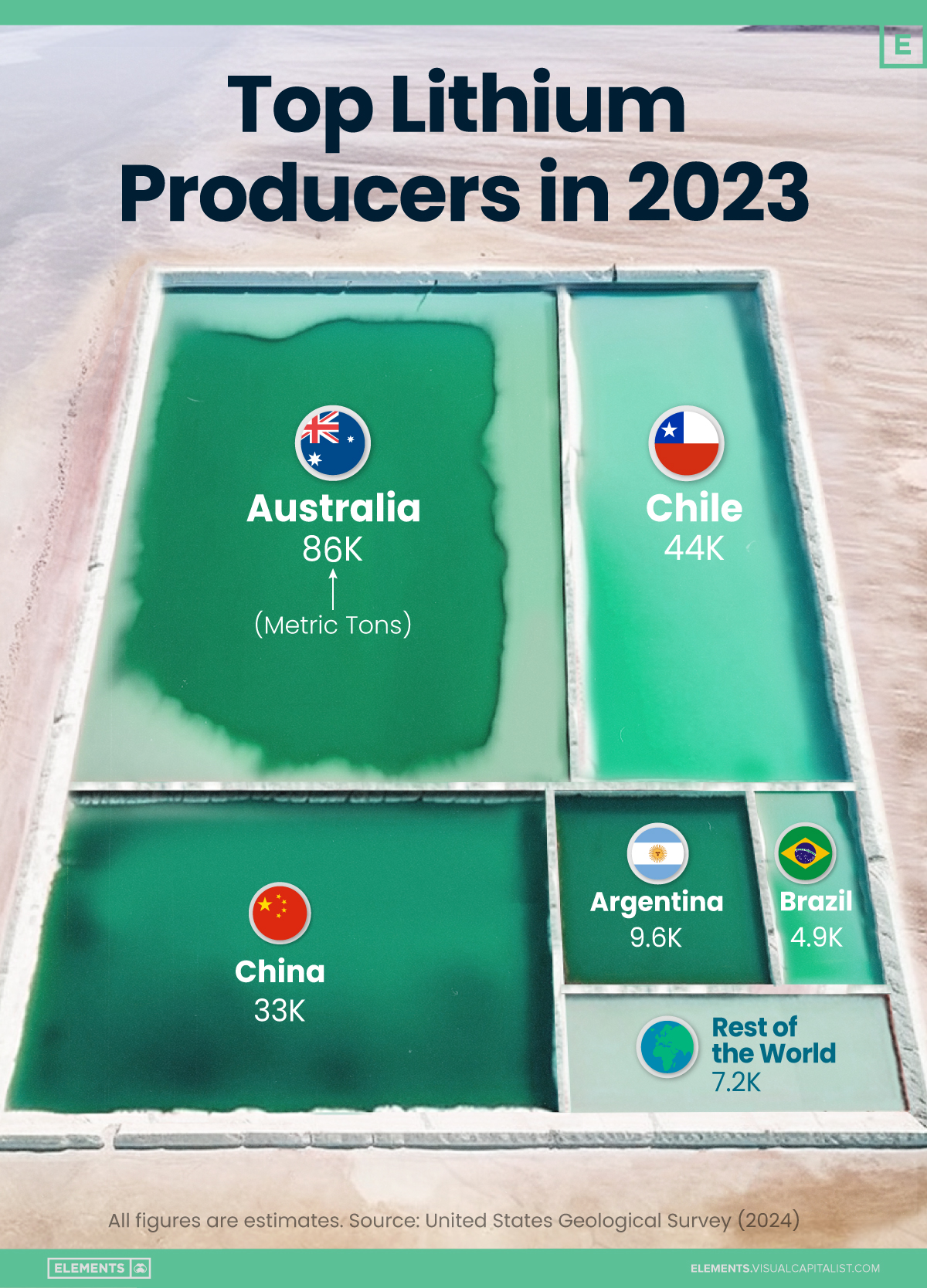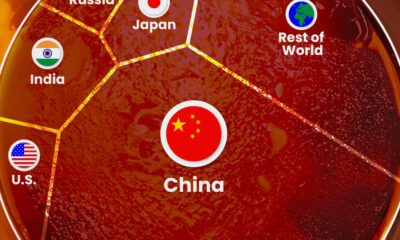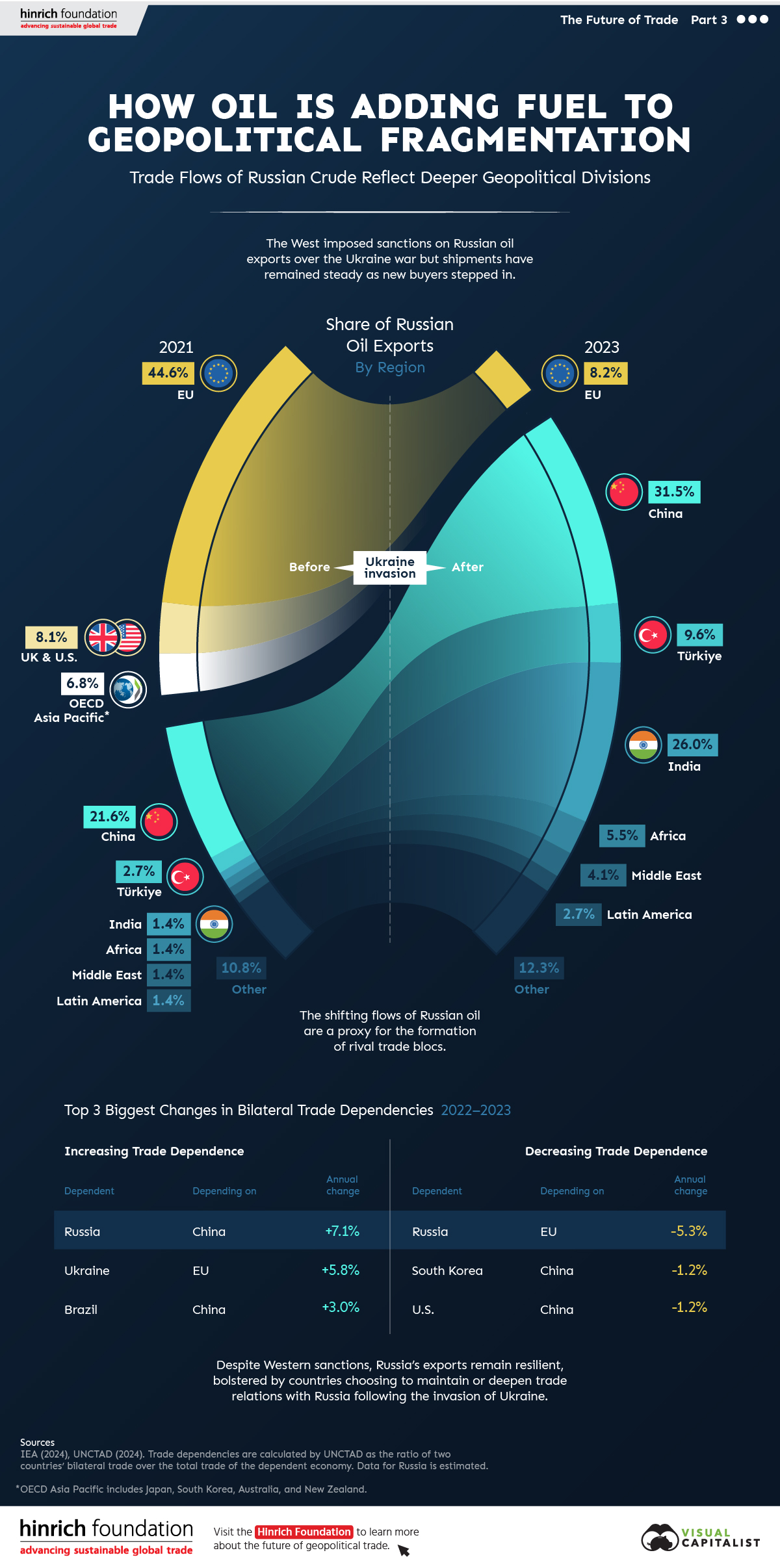Energy
Ranked: The World’s Largest Lithium Producers in 2023
![]() See this visualization first on the Voronoi app.
See this visualization first on the Voronoi app.
The World’s Largest Lithium Producers in 2023
This was originally posted on our Voronoi app. Download the app for free on iOS or Android and discover incredible data-driven charts from a variety of trusted sources.
Three countries—Australia, Chile, and China—accounted for 88% of lithium production in 2023.
In this graphic, we list the world’s leading countries in terms of lithium production. These figures come from the latest USGS publication on lithium statistics (published Jan 2024).
Australia Leads, China Approaches Chile
Australia, the world’s leading producer, extracts lithium directly from hard-rock mines, specifically from the mineral spodumene.
The country saw a big jump in output over the last decade. In 2013, Australia produced 13,000 metric tons of lithium, compared to 86,000 metric tons in 2023.
| Rank | Country | Lithium production 2023E (metric tons) |
|---|---|---|
| 1 | 🇦🇺 Australia | 86,000 |
| 2 | 🇨🇱 Chile | 44,000 |
| 3 | 🇨🇳 China | 33,000 |
| 4 | 🇦🇷 Argentina | 9,600 |
| 5 | 🇧🇷 Brazil | 4,900 |
| 6 | 🇨🇦 Canada | 3,400 |
| 7 | 🇿🇼 Zimbabwe | 3,400 |
| 8 | 🇵🇹 Portugal | 380 |
| 🌍 World Total | 184,680 |
Chile is second in rank but with more modest growth. Chilean production rose from 13,500 tonnes in 2013 to 44,000 metric tons in 2023. Contrary to Australia, the South American country extracts lithium from brine.
China, which also produces lithium from brine, has been approaching Chile over the years. The country increased its domestic production from 4,000 metric tons in 2013 to 33,000 last year.
Chinese companies have also increased their ownership shares in lithium producers around the globe; three Chinese companies are also among the top lithium mining companies. The biggest, Tianqi Lithium, has a significant stake in Greenbushes, the world’s biggest hard-rock lithium mine in Australia.
Argentina, the fourth country on our list, more than tripled its production over the last decade and has received investments from other countries to increase its output.
With all the top producers increasing output to cover the demand from the clean energy industry, especially for electric vehicle (EV) batteries, the lithium market has seen a surplus recently, which caused prices to collapse by more than 80% from a late-2022 record high.
Oil and Gas
How Oil Is Adding Fuel to Geopolitical Fragmentation
Which countries and regions decreased, banned, or increased Russian oil imports following the 2022 invasion of Ukraine?

How Oil Is Adding Fuel to Global Fragmentation
Russia’s invasion of Ukraine in February 2022 led to severe bans or restrictions on Russian oil from the West. Meanwhile, other nations—including China, India, and Türkiye—opted to deepen trade ties with the country.
This graphic from the Hinrich Foundation is the final visualization in a three-part series covering the future of trade. It provides visual context to the growing divide among countries shunning Russian oil versus those taking advantage of the excess supply.
Which Countries Have Decreased or Banned Russian Oil Imports?
This analysis uses data from the IEA’s February 2024 Oil Market Report on Russian oil exports from 2021 to 2023.
Following the invasion, both the U.S. and the UK enacted a complete ban on Russian crude. Imports dropped from 600,000 barrels per day (bpd) in 2021 to zero by late-2022.
| Country/Region | 2021 (bpd) | 2022 (bpd) | 2023 (bpd) | Change; 2021-2023 (bpd) |
|---|---|---|---|---|
| EU | 3.3M | 3.0M | 600K | -2.7M |
| UK & U.S. | 600K | 100K | 0 | -600K |
| OECD Asia | 500K | 200K | 0 | -500K |
Similarly, the EU, which has historically been more reliant on oil from Russia, dropped imports by over 80%, from 3.3 million bpd in 2021 to 600,000 bpd in 2023.
OECD Asia-Pacific—which includes Japan, South Korea, Australia, and New Zealand—also slashed their Russian oil imports.
Which Countries Have Increased Imports of Russian Oil?
The pullback in demand for Russian crude from the West created a buying opportunity for countries and regions that chose not to support Western sanctions.
| Country/Region | 2021 (bpd) | 2022 (bpd) | 2023 (bpd) | Change; 2021-2023 (bpd) |
|---|---|---|---|---|
| India | 100K | 900K | 1.9M | +1.8M |
| China | 1.6M | 1.9M | 2.3M | +700K |
| Türkiye | 200K | 400K | 700K | +500K |
| Africa | 100K | 100K | 400K | +300K |
| Middle East | 100K | 200K | 300K | +200K |
| Latin America | 100K | 100K | 200K | +100K |
| Other | 800K | 600K | 900K | +100K |
India increased its imports of oil from Russia, by the largest amount from 2021 to 2023—up to 1.9 million bpd from only 100,000 bpd.
China, the biggest net importer, also saw a large uptick. The country boosted imports for Russian oil by over 40% over this timeframe. Türkiye increased imports of Russian crude by an additional 500,000 bpd.
Several other regions—such as Africa, the Middle East, and Latin America—saw slight upticks in imports.
Shifting Trade Dependencies
The dynamics present in the global crude market underscore broader trends in Russia’s trade relationships. Russia is becoming increasingly less economically reliant on the West and more reliant on China.
From 2022 to 2023, the largest upward shift in the UNCTAD’s bilateral trade dependency estimates was Russia’s increased reliance upon China (+7.1%).
| Dependent | Depending On | Annual Change |
|---|---|---|
| Russia | China | +7.1% |
| Ukraine | EU | +5.8% |
| Brazil | China | +3.0% |
Note: Trade dependencies are calculated by UNCTAD as the ratio of two countries’ bilateral trade over the total trade of the dependent economy.
In fact, China threw a lifeline to Russia in the aftermath of the Ukraine invasion. The Atlantic Council reported that Chinese exports to Russia have grown 121% since 2021, while exports to the rest of the world have increased by only 29% in the same period.
In contrast, Russia also exhibited a large decrease in reliance on the EU (-5.3%). South Korea and the U.S. have made shifts to further distance themselves from China as geopolitical tensions continue to mount.
| Dependent | Depending On | Annual Change |
|---|---|---|
| Russia | EU | -5.3% |
| South Korea | China | -1.2% |
| U.S. | China | -1.2% |
As the Russian oil market shows, geopolitical tensions have the potential to significantly impact trade. Though Russian crude exports remained steady amid the conflict, this necessitated a shift in its main trading partners.

Visit the Hinrich Foundation to learn more about the future of geopolitical trade

-

 Energy2 weeks ago
Energy2 weeks agoComparing Saudi Aramco’s $1.9T Valuation to Its Rivals
See how much larger Saudi Aramco’s market cap is compared to rivals like Chevron, ExxonMobil, and Shell.
-
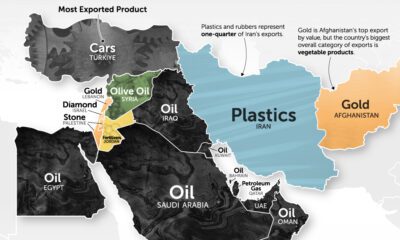
 Energy7 months ago
Energy7 months agoMapped: The Top Middle East Exports by Country
It’s more than just oil. This map of Middle East exports shows the top global product of each country by value.
-
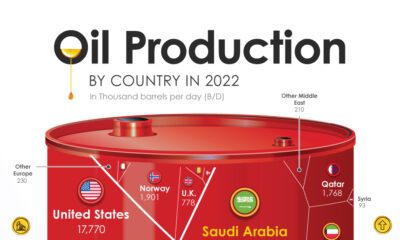
 Countries9 months ago
Countries9 months agoCharted: The World’s Biggest Oil Producers
Just three countries—the U.S., Saudi Arabia and Russia—make up the lion’s share of global oil supply. Here are the biggest oil producers in 2022.
-

 Economy1 year ago
Economy1 year agoPrediction Consensus: What the Experts See Coming in 2023
Using our database of 500+ predictions from reports, articles, interviews, and more, we highlight what experts think will happen in 2023
-
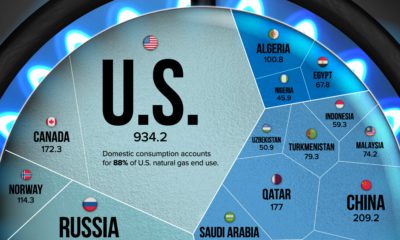
 Oil and Gas2 years ago
Oil and Gas2 years agoWhich Countries Produce the Most Natural Gas?
Natural gas prices have risen since Russia’s invasion of Ukraine. This visualization highlights the world’s largest natural gas producers.
-
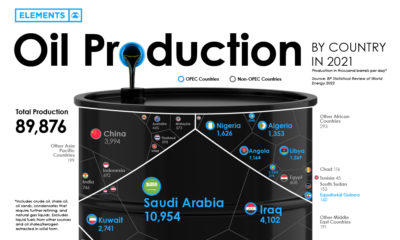
 Oil and Gas2 years ago
Oil and Gas2 years agoVisualizing the World’s Largest Oil Producers
Global oil production averaged 89.8 million barrels of oil per day in 2021. Here are the world’s largest oil producers.
-

 Economy5 days ago
Economy5 days agoRanked: The Countries Most Dependent on Agricultural Exports
-
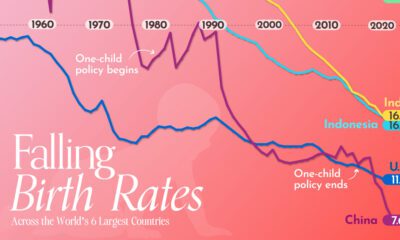
 Demographics2 weeks ago
Demographics2 weeks agoCharted: Declining Birth Rates in the Most Populous Countries (1950-Today)
-

 Technology2 weeks ago
Technology2 weeks agoVisualizing the Training Costs of AI Models Over Time
-
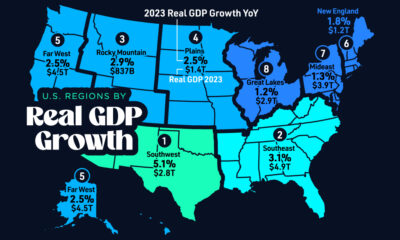
 Maps2 weeks ago
Maps2 weeks agoMapped: The Real GDP Growth of U.S. Regions in 2023
-

 Technology2 weeks ago
Technology2 weeks agoCharted: How Many Data Centers do Major Big Tech Companies Have?
-

 Globalization1 week ago
Globalization1 week agoCharted: Countries Offering Digital Nomad Visas
-

 Politics1 week ago
Politics1 week agoMapped: Unauthorized Immigrants by State
-

 Technology1 week ago
Technology1 week agoVisualizing the 15 Most Valuable Bitcoin Addresses

